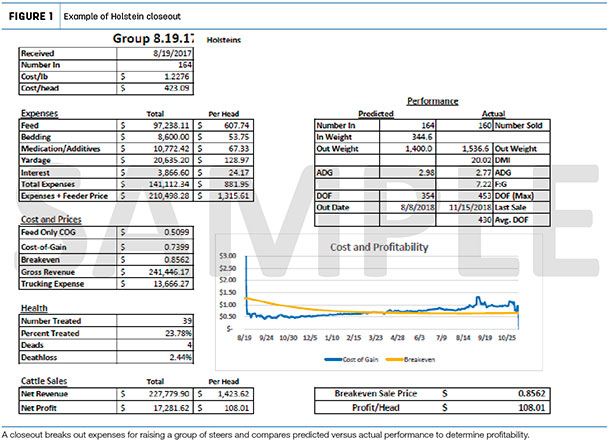Feedlot closeouts are a valuable tool for producers to use to summarize and analyze the performance of their feedlot cattle. Analyzing the results from each group of cattle can help assess and compare management practices and determine those that are doing well, in addition to pointing out factors that might have room for improvement.
Closeouts and good recordkeeping are vital in determining cost of production, break-even points and performance parameters to enable you to make sound management decisions moving forward. By looking at current records on a group of cattle, you may also be able to make adjustments midcourse to improve the outcome at market time. Knowing what the breakeven is can help make marketing decisions. In addition, closeouts, performance data and good financial records can be helpful in discussions with your lender, veterinarian, feed supplier and other industry professionals.
Click here or on the image above to view it at full size in a new window.
Getting the best information from a closeout starts with putting in good information. Accurate and detailed recordkeeping is vital. Whether using a computer program, cell phone, tablet or a notebook, the data recorded on a daily, weekly or monthly basis is what is needed to calculate your closeouts.
The basic pieces of information needed to calculate feedlot closeouts are:
- Pen/lot number
- Cattle in weight, date, number of head and cost
- Pounds of feed consumed and all feed costs
- Vet and medicine
- Bedding, yardage and interest
- Cattle out weight, date, number of head and sale price
It is important to note that if raising cattle born on your farm, you should assign a value to them to get accurate data. Figure in the amount that would be received for the sale of the bull calf.
The data and performance measurements obtained from the closeout are:
- Days on feed
- Average daily gain
- Feed conversion/feed efficiency
- Dry matter intake
- Feed cost of gain
- Total cost of gain
- Profit per head
- Death loss
- Break-even value
Recording pen/lot conditions, weather conditions, treatments given, implants, vaccinations, pen moves and marketing information such as carcass scores and shrink can all provide valuable information to aid in cattle performance assessment. By tracking this data over time, producers can establish the operation’s “benchmark,” or average performance over a period of time. This will allow producers to see how certain changes can affect the outcome of the cattle, whether it be related to health, performance or economic results. These results can also be compared to industry standards to see how performance measures up against fellow producers in the industry.
A summary of Holstein closeouts from 2015 to 2018 in the Form-A-Feed OPTIC Feedlot Database demonstrates there can be significant differences in performance parameters. This summary showed that feed-to-gain ratios varied from 6.58 to 7.70, and total cost of gain ranged from 69 cents per pound to over 80 cents per pound. Substantial variations were also seen in break-even prices. This summary of closeouts showed a range of breakevens from 97 cents per pound to $1.35 per pound. These figures demonstrate the value in tracking cattle and reviewing closeouts to understand what the feedlot is doing well, what it’s not and how it can improve.
Tips for better records and closeouts
- Train employees on record-keeping systems, how to enter information and how to interpret basic data.
- Inventory feed, bedding, medication and other supplies weekly.
- Monitor feed intakes daily, and sample feed on a regular basis.
- Continually monitor cost of gain, breakeven and projected market date, and weight.
- Measure and record feed refusals and waste, and adjust as necessary.
- Utilize cattle projections or previous closeouts to estimate gain and performance. Use both of those tools to compare to progress of current groups of cattle.
- Evaluate the effectiveness of health management practices at least yearly.
In times of low prices and economic struggle, we all want to maximize our profits, operate as efficiently as possible and look for additional income. Closeout data can help compare the financial impact of raising steers compared to the dairy operation. Compare and consider resources such as facility availability, feed supply, labor requirement, manure management and return on investment. ![]()
Sara Kleyer is a livestock records specialist with Form-A-Feed.

-
Lisa Wuertz
- Marketing Administrator
- Form-A-Feed










